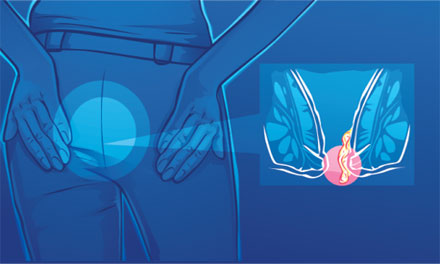
ABOUT
CRYOCURETM
The CRYOCURETM is an anal device that can be used for the treatment of hemorrhoids (Piles) and anal thrombosis. The cold CRYOCURETM stick causes the blood vessels to constrict, so that the blood flow to the swollen tissue diminishes. As a result of this the haemorrhoids will shrink and the anal oedema decreases. Complaints like pain, itching, burning and loss of blood will be reduced or even disappear.
WORK
CRYOCURETM is an MDD-CE Approved medical device based on cryogenic treatment designed to work at -20*C. Cryogenic treatments for Haemorrhoid is very well proven, but it is generally done in an Hospital setting at -78*C, the liquid nitrogen temperature, this is really not required, just -20*C at home will do the job.
The CRYOCURETM must be inserted into the anus, because the cause of all anus com-plaints lies 2 cm into the anal tract. That is a place that needs to be handled with care.
Since the cause of anal complaints is usually located in the rectum, which is also where haemorrhoids are located, it makes sense that researchers looked for a tool that can apply the cryogenecis at the right place – that is 2 cm deep – in the rectum.
This is possible now with the CRYOCURETM. Due to the effect of extreme cold induced by CRYOCURETM, the blood vessels of the haemorrhoid in the rectum shrink, causing the existing inflamation to cool down and become less painful. This will make the bleeding, as well as itching and discharge, stop or strongly decrease it.
BENEFIT
The CRYOCURETM works according to the Cryogenic principle. No medicine or any kind of drug enters the intestine. Many patients have adverse reactions to haemorrhoid salves and suppositories. The CRYOCURETM can be used during pregnancy also.
WHEN TO USE
Any time you are diagnosed that you suffer from Heamorrhoids, you can use the CRYOCURETM If desired, the CRYOCURETM can be used multiple times per day. In case of serious complaints, the CRYOCURETM will brings long-term relief after repeated use.
In which cases do you use CRYOCURETM
You can use the CRYOCURETM to:
- Quickly stop the bleeding of haemorrhoids
- Decrease or stop anus itch
- Combat anus pain
- Alleviate the infection
Haemorrhoids
About 2 cm. above the anus opening, a number of bumps are located, which hold back gas and faeces together with the sphincter. When someone needs to pass gas or feels the need to defecate, the cavernous tissue shrinks and the sphincter opens, so gas or faeces can go out. Without this cavernous tissue, a human would not be able to retain their gas and thin faeces. The sphincter cannot do this delicate work on its own. That is why the cavernous tissue is necessary. If, however, the cavernous tissue becomes much larger than necessary and if it is also pushed down due to hard pressure during defecation, and sometimes even hangs outside of the anus andbleeds, we speak of haemorrhoids.
So: haemorrhoids are cavernous tissue that has become much too large.
What causes cavernous tissue to degenerate into haemorrhoids is still unknown.
Possible causes include: weak connective tissue, too spicy food, alcohol, obesity,
coughing, use of laxatives and diseases of the rectum.

Cause
The most common complaint is blood loss. The patient loses clear red blood during or after bowel movement. Another complaint is itching. Itching develops because the haemorrhoids are squeezed full of blood. A third complaint is that the patient has the feeling of something in the rectum that feels like a swelling or faeces that does not come out. This feeling arises because of the presence of very large haemor-rhoids, which are stowed up with blood on top of that. These haemorrhoids give the feeling of needing to defecate without being able to. Such a large haemorrhoid can sometimes also make it difficult for faeces to come out of the rectum. Pushing during defecation has no result in such cases. Should you do this regardless, the haemor-rhoids will come to hang outside of the anus in the long term, and then we speak of a rectal prolapse.

